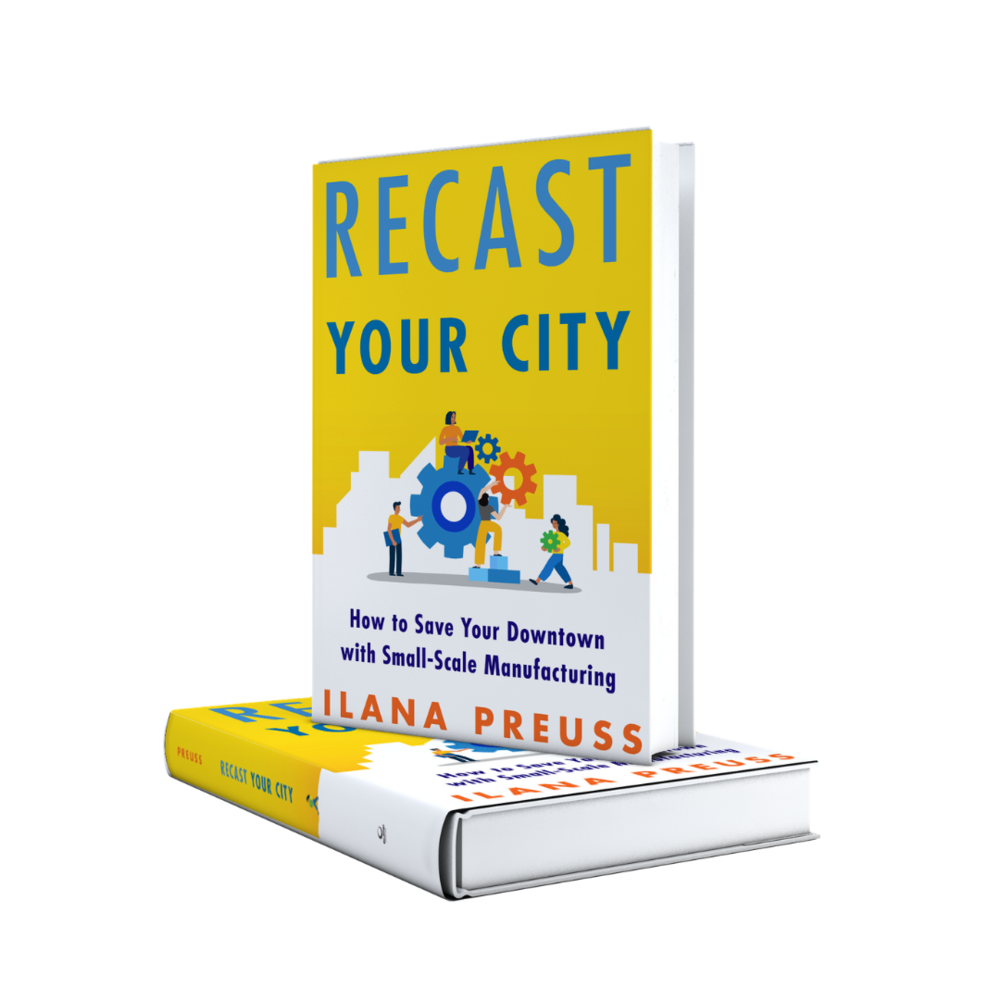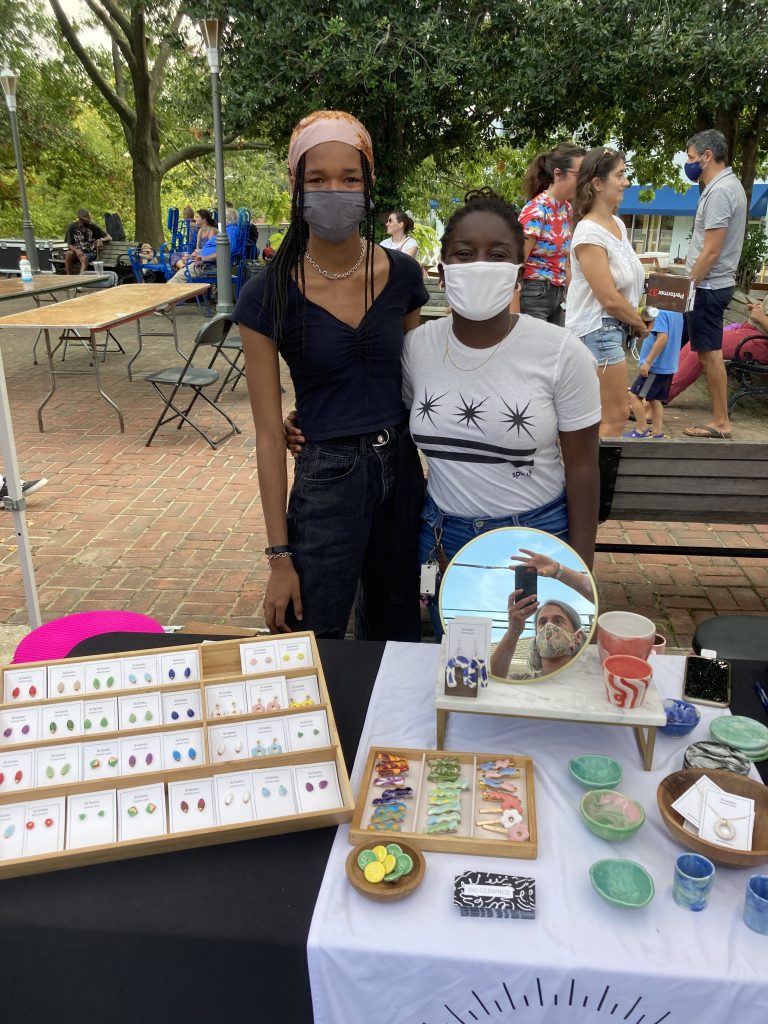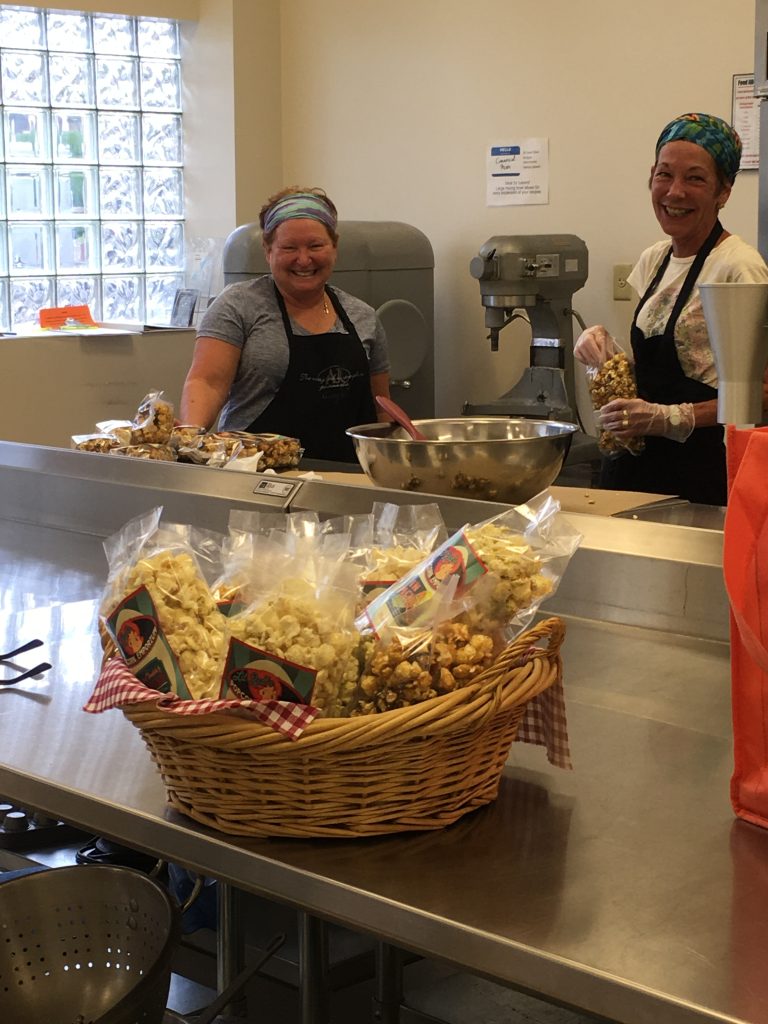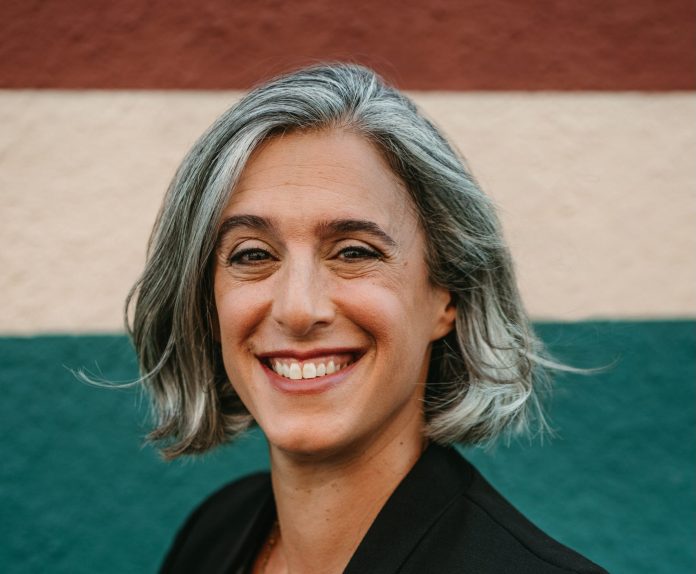Recast Your City is subtitled “How to save your downtown with small-scale manufacturing,” which gives the impression that it’s a one trick book. But its author Ilana Preuss calls it a “community development self help book,” and it actually pulls off this feat. To do so, the book takes some very interesting turns, including a scathing critique of current economic development policies as well as a guide to having authentic conversations across communities.
Ilana Preuss is the former chief of staff at Smart Growth America and past head of the technical assistance program at the US Environmental Protection Agency’s Smart Growth Program. Currently, she is the founder and CEO of Recast City, an organization that works with local leaders to build economies through small-scale manufacturing. She talked with The Urbanist’s Ray Dubicki, who frequently writes about industrial land use, over Zoom about her book, the ways in which planners talk at people, and unique economic development lingo. The conversation has been edited for length and clarity.
Ray:
Small scale manufacturing in storefronts as an economic development tool is a novel idea. How has that been received?
Ilana Preuss:
I think a lot of places realize that what they’ve been trying to do for the last few decades hasn’t been working. It worked for a few lucky places, but most are just not going to win the recruitment competition. They are who they are, and that’s a good thing! People are incredibly receptive when you go to them and say the skills that you have are valuable, you are worthy. And a big part of what we do in this work is find the people who have those skills who want to do this.
Ray:
The recruitment competition is about luring new businesses and jobs to a town with tax breaks that never pay for themselves. Amazon’s HQ2 is mentioned a few times in your book, and the first part is actually a takedown of this 1970s style economic development model. Why has this model has stuck for 50 years?

Preuss:
To some degree, it’s the psychology of our country, like new and shiny and big is always better. The whole concept that you can recruit the new and shiny and big. Especially from a political standpoint, ribbon cutting is considered a much bigger success than a new storefront. So much so that in a lot of communities the economic development authority does not have anything to do with storefronts. There’s this huge bifurcation in economic development where the economic development authority sees their job as only recruitment and marketing and retention of the bigger folks.
But who does care and feeding of small businesses? Some had a small business program eventually, but wasn’t part of their day to day. In community development and planning, you copy things. Most aren’t coming up with the brand new idea. They’re copying things that they see around them. And if they you see it worked somewhere, it should work for you.
Ray:
Who is the “you” reading this book?
Preuss:
Economic development folks and planning are sort of the two main audiences for the book. But this is this is cumulative. This is a comprehensive set of groups that nobody really pays attention to individually. When we look at them all together, they have the potential for a remarkable impact on our communities. My work has always focused on getting people to understand what the potential is, and then getting them to implementation as quickly as possible, with plenty of examples of this stuff working all over the place.
That being said, it is a tool for everybody in the community to use if there’s vacant storefronts in your community and doing something about it is a part of your interest. The book is for you so I write in plain English, because I think that’s what everybody understands.
There’s so many professional fields where people speak in their secret language. And that’s why things stay siloed. I’ve worked community development which is about working as a translator. How are you connecting the dots across these different areas of work to make the good stuff happen?
Ray:
My editor is trying to beat the phrase “built form” out of me.
Preuss:
Just say the word “building”! Don’t make it fancy.
I was the vice president and chief of staff at Smart Growth America eons ago. And when you talk about smart growth seven times in the same two paragraphs, you have to get really creative about what else you call it. I had to get really good. And under the Obama administration, I helped run a grant program for Start Growth America with the Sustainable Communities Program at HUD, where I got to run around the country teaching planners how to speak non wonk, which is really great. So that was a lot of fun.
Ray:
A good turn of phrase in the book is calling small-scale manufacturing “hot sauce, handbags, and hardware.” What got you interested in those?
Preuss:
They all had H’s. You know, it’s really hard to find things that are catchy about all this. When I picked small scale manufacturing as a name for the sector very specifically, people don’t know what that is without you defining it.
It’s really important to define what we’re talking about very quickly. And be very clear in regular English what we’re doing, why we’re doing it and who benefits from what are we are really working on. So finding a phrase like hot sauce, handbags, and hardware was important for me. Hot sauce, alludes to the food product industry, which a lot of people don’t think about when they’re thinking about small product businesses in their community. Handbags is the whole world of textiles, which is at the small scale modern manufacturing and a phenomenal neighbor. And something I would want in any one of my storefronts where they can do production and retail in the same place. And then hardware is the nod towards advanced manufacturing. The gadgets, it’s about tech also.

Ray:
Our tech heavy city of Seattle has a lot of new development with empty storefronts. How could that small scale manufacturing help places that are running a little low on affordable spaces?
Preuss:
So the challenge is that new construction, especially mixed use, is really expensive to build. Unless the developer is saying from the very beginning, “we are going to offset the leases on our ground floor because we’re going to create a cool brand out of that. And we’re going to make it up on our upstairs in the way we financially model the whole thing,” then you end up where they have to get a certain revenue out of that ground floor. That’s the reality of most new construction.
Right now, some of the smarter, larger developers are making that swap. They just cover cost of construction with the ground floor. Which is where small scale manufacturing can thrive. Commercial space in a state of good repair in fact a public good that we have a responsibility around. No different than affordable housing.
There’s some great examples. One in DC called Monroe Street Market. In their negotiation with the city, they said they will create micro retail storefronts for artists and artisans on the pedestrian walkway that goes through the project. Part of their decision making was that if they could do something really cool on that walkway, which is non prime real estate, it could create a stronger brand for their high end apartments upstairs. And that’s exactly what they’ve done.
Those micro retail spaces that are between 400 and 800 square feet and have shared bathrooms. So they’re they’re more cost effective in that way. The developer made a 30 year lease rate commitment, just like affordable housing commitments. And when they made that commitment, it was just below market rate. It’s now probably 50% of the lease rate of what it would cost to get an industrial space in the city. Which you can’t get for the same reason that you can get in your community. It is the frothiest part of our market because of the because of all these other uses that have nothing to do with small scale manufacturing and lots of good paying jobs.
Ray:
The market is frothy?
Preuss:
A broker used that phrase once when I was looking at a space a bunch of years ago. It’s gonna go fast! It’s a very frothy time. I kept that word.
Ray:
The book talks a lot about moving the economic development discussion past usual suspects. Not just land owners, but also those real estate brokers and small manufacturing businesses. Why is it important to grow the network of people you’re talking to in a way that breaks out of the old network?
Preuss:
It’s not just growing it, it’s actually being incredibly targeted. I think economic development and planning spend a lot of time just so just saying the word “public.” At some point, it is the entire community.
In the world of marketing and PR, you’re never allowed to say “public.” You have to say who is your target audience in a really specific way. The same thing with business growth. You have your business avatar, the person who you trying to sell to.
So there are people that most community leaders do not know. In most communities, the hardest part for leaders is figuring out who to talk to. Network bias is who you know, and historically, you would just send the things out into the world and the people who were connected well to the city would know about it. That was it.
At this point, we have a better understanding and a responsibility to do things really differently. People were historically excluded. People didn’t benefit. A White household will have 10 times that the household wealth of a Black or Latino household. We want to address economic equity, We want to address the fact we have the highest income inequity ever recorded, we want to address any of those things.
From an economic development standpoint, if you’re not addressing your community across your demographic diversity, you’re not going to make a big impact on your economy. You’re not helping enough of the different people who actually need help. You’re helping the known suspects.
Ray:
You instruct folks to contact that expanded network and ask questions with a purpose. A lot of that purpose is to identify gaps and overlaps, and then turn those into discrete tangible action steps. How did these purposeful questions draw from tech companies and user research?
Preuss:
Part of user research is design thinking. It depends on whose perspective you’re coming in from and asking these open ended questions about how people operate. According to this work, people are notoriously bad at predicting how they will act, but are very good at telling you about how they act now.
The whole set of questions is really about understanding product business owners. What kind of resources do you use now? What’s challenging for you about having a business here?
People aren’t necessarily able to tell you what’s missing, but they can tell you what’s hard about having a business. Part of our job is to understand based on what they say and we can fill in those gaps or know that there’s an asset that’s already there that fills that gap.
I don’t ever want to go work in a community and always say you need a business training program. My whole goal with understanding the assets and challenges goes back to what’s the outcome we’re trying to achieve. And that’s why we start with outcomes and who should benefit. Because there’s going to be a hundred different things that we could do. But we want to pick the shortlist that helps us get to that outcome and to the target audience we want to benefit as quickly as possible.

Ray:
In that way, you turn the phrase “highest and best use” on its head. Usually it’s about the tallest building, but you suggest it should be based on the outcome we want to achieve. What changes when you talk to people about changing that perception?
Preuss:
Highest and best use in most conversations is this term that is just thrown around at all levels of government, and they don’t define it. What they actually mean is highest and best use for us to get the most property taxes or sales taxes out of this piece of our land.
I think the more important question to ask is highest and best use to what purpose? What outcome are we trying to achieve? And who do we want to benefit? And the highest and best use might be affordable commercial space for for businesses that create good paying middle income jobs, because that’s what our community is missing. And then that’s going to be highest and best use. If you want purely property tax revenue purposes, then be explicit about it, then we can have a conversation.
My role in a lot of forums is to ask these kinds of questions. To be able to say, “we throw these terms around, let’s be clear about what we mean when we say them.” When we ask the question about who should benefit from this, it sort of stops people in their tracks. To really, honestly think about it for the first time. The question opens some really wonderful conversations with people and communities in different leadership roles and for profit, nonprofits. Have real conversations about stuff that’s hard to talk about.
Want to learn more about how industry can be brought back into cities? Read Ray Dubicki’s five part series, Your Friendly Neighborhood Industrial Use. The first article in the series is linked below.
Ray Dubicki is a stay-at-home dad and parent-on-call for taking care of general school and neighborhood tasks around Ballard. This lets him see how urbanism works (or doesn’t) during the hours most people are locked in their office. He is an attorney and urbanist by training, with soup-to-nuts planning experience from code enforcement to university development to writing zoning ordinances. He enjoys using PowerPoint, but only because it’s no longer a weekly obligation.


